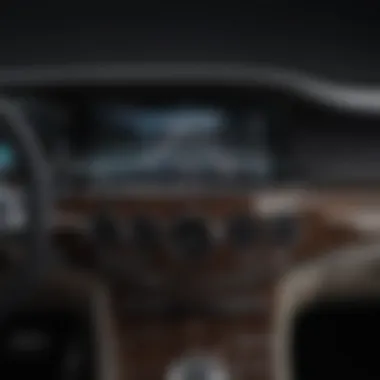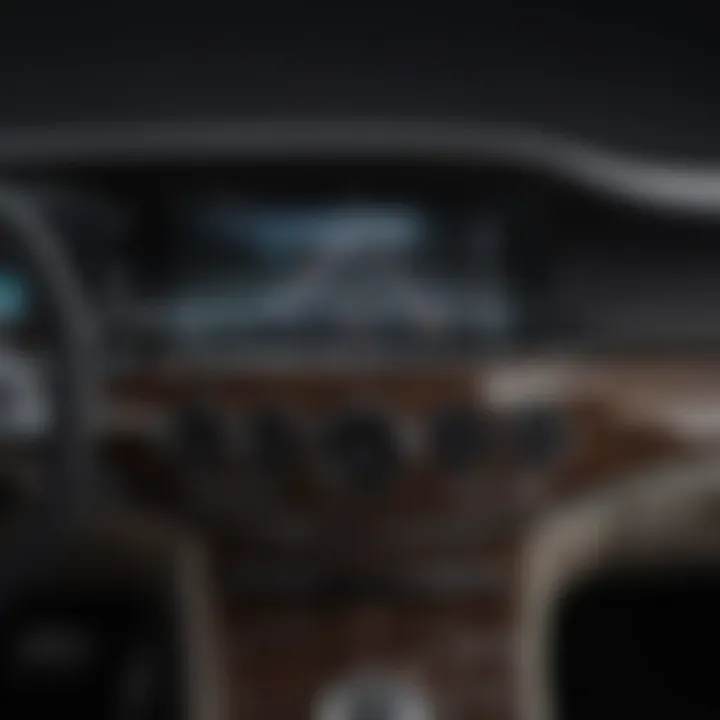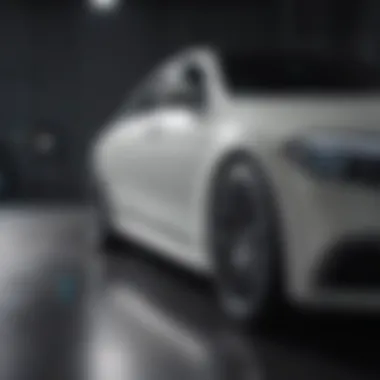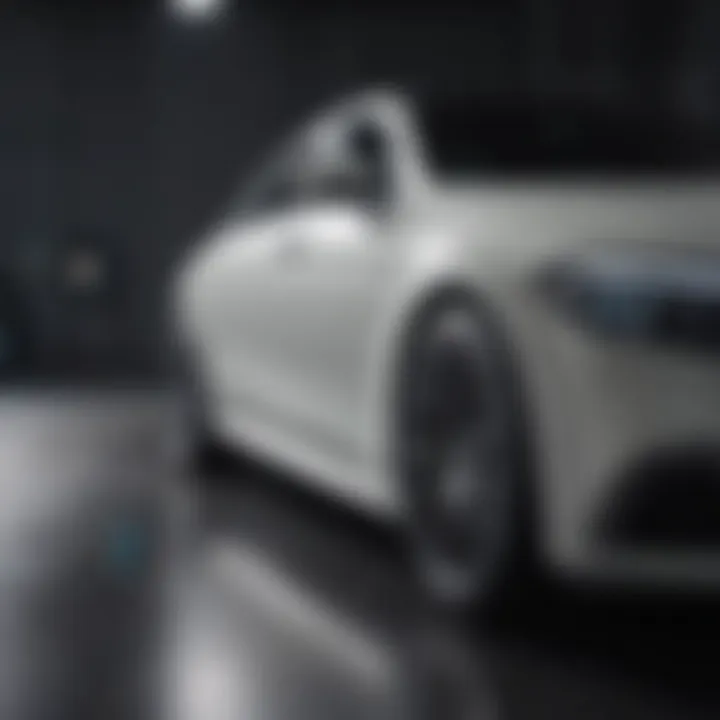Exploring Self-Driving Innovations in the Mercedes S-Class


Intro
As we navigate through the labyrinthine world of modern automobiles, few models stand out quite like the Mercedes S-Class. It has long been synonymous with luxury, performance, and a certain undeniable prestige. But beyond its lavish interiors and smooth rides, this vehicle is steering headfirst into the future with an impressive array of self-driving capabilities. In this exploration, we will peer into the intricate workings that elevate the S-Class from merely a mode of transport to a technological marvel. Let's buckle up and take a closer look at what makes this car not just an automobile but a signpost of innovation in the automotive sector.
Car Reviews
Overview of the Vehicle
The Mercedes S-Class isn't just another vehicle on the road; it's a statement. Launched as part of Mercedes-Benz's flagship line, its evolution has seen a steady rise in sophistication. At its core, the S-Class is equipped with both traditional combustion engines and hybrid variants, showcasing the brand's commitment to versatility. Enveloping drivers in plush materials and cutting-edge technology, it effectively embodies the brand's reputation for excellence.
Performance Analysis
When it comes to performance, the S-Class pulls no punches. Its engines range from the robust V6 to the more thrilling V8 options, each delivering a seamless experience on the road. Features like the AIRMATIC suspension system enhance ride comfort, while the 4MATIC all-wheel-drive provides a confident grip across various terrains. However, the heart of the vehicle's performance lies in its intelligent driving systems that optimize efficiency without sacrificing power.
Design and Interior Features
Step inside the S-Class and one is welcomed by an atmosphere that blends elegance with state-of-the-art technology. The cabin features an array of ambient lighting, plush leather seating, and the renowned MBUX infotainment system, allowing intuitive control over media, navigation, and even climate settings. The emphasis on user experience transforms mundane drives into first-class journeys. Every curve, button, and screen is meticulously crafted to enhance comfort and accessibility.
Safety Ratings and Specifications
Safety is paramount in the design of the S-Class. Advanced features such as Pre-Safe® technology, which prepares the vehicle for a collision before it happens, highlight the forward-thinking approach Mercedes has embraced. Moreover, numerous crash tests have left the S-Class with high safety ratings, solidifying its stature as one of the safest options in its class. With an arsenal of sensors and cameras, it ensures that drivers remain alert and prepared, even during autonomous driving.
Value for Money
While the S-Class does come at a premium price, many argue that its value extends beyond mere specifications. Getting behind the wheel is akin to stepping into a high-end living room—one that can whisk you away with the touch of a button. The rich features, unmatched comfort, and cutting-edge technology make it a worthwhile investment for those on the cusp of luxury and innovation.
Automotive Industry Trends
Emerging Technologies
In the grand theatre of the automotive industry, self-driving technology is drawing a lot of attention. As players like Tesla dominate headlines, traditional manufacturers like Mercedes are not standing idle. Emerging technologies are being woven into vehicles like the S-Class, where AI and machine learning play crucial roles. Advanced radars and cameras are enhancing the vehicle's ability to navigate complex driving scenarios with elegance.
Changes in Consumer Preferences
The tide is shifting in terms of what consumers expect from their vehicles. Today's drivers are no longer content with just horsepower and luxurious interiors. Many are seeking advanced technologies that improve safety and convenience, placing a higher value on automated features. The S-Class stands as a prime example of a vehicle that meets these shifting preferences head-on.
Sustainability and Eco-Friendly Practices
With environmental issues taking center stage, manufacturers are increasingly investing in sustainable practices. The S-Class features hybrid and electric variants, integrating eco-friendly technology without sacrificing performance. This aligns with a growing demand for greener alternatives in the automotive market, signaling an important trend that future products will likely continue to embrace.
Future of Electric Vehicles
The path forward seems entrenched in electric mobility. Many experts predict that electric vehicles (EVs) will dominate the landscape before long. With the Mercedes S-Class leading the charge with its hybrid options, the brand is well-positioned to evolve. Future models may showcase fully electric variants that encapsulate the luxury and technological prowess the S-Class is known for.
Industry Challenges and Solutions
Nevertheless, the road ahead is not free from potholes. Challenges ranging from technical limitations to regulatory hurdles persist. It's crucial for manufacturers to innovate continuously while adapting to legal requirements and public expectations. Resolving these challenges is essential not only for the S-Class but for the industry as a whole, as autonomous vehicles inch closer to mainstream acceptance.
Culmination
The Mercedes S-Class, in its exploration of self-driving capabilities, mirrors a larger narrative within the automotive sector. From luxurious interiors to tech-galore features, it represents more than just a car—it's a glimpse into the future. While enjoying its comforts, one also embraces an evolving landscape marked by emerging technologies, safety enhancements, and a commitment to sustainability. Through this analysis, we appreciate not just the vehicle itself but the journey ahead for the automotive industry.
Preface to the Mercedes S-Class
When we talk about luxury vehicles, the Mercedes S-Class often pops up as a prime example. It's not just a car; it's a statement. It combines elegance with capability in a way few others manage to do. The S-Class has set high standards in the automotive industry, serving as the benchmark for both performance and comfort. This might seem like mere marketing chatter, but the car's historical significance and evolution show a deeper connection to technological advancement and user demands.
The S-Class series, known for its plush interiors and cutting-edge tech, is more than just a mode of transport. It reflects years of dedication to engineering excellence. Many enthusiasts and prospective buyers look at this model not just for its luxury but also for its technological innovations, especially in self-driving capabilities.
Historical Significance
The Mercedes S-Class first hit the market in 1972, aiming to redefine what a luxury sedan could be. The car’s name itself, "S-Class," signifies "Sonderklasse" in German, translating to "special class." Over decades, it became a forerunner in not only luxury but also safety features. For example, the introduction of anti-lock braking systems and, later, stability control set trends that many other manufacturers began to follow.
What's intriguing about this model is how it has often been ahead of the curve in adopting new technologies, serving as the testbed for innovative features. It has paved the way for advancements in automotive technology, including some features that now feel commonplace in modern vehicles. Such a historical trajectory makes the S-Class a symbol of luxury, reliability, and pioneering spirit in the realm of high-end automobiles.
Evolution of the Model
The evolution of the Mercedes S-Class is a testimony to the brand's commitment to staying ahead in an ever-changing automotive landscape. The progression can be marked by several key milestones.
- First Generation (W116): Launched in the 1970s, this was the model that started it all, bringing together both comfort and performance with robust engineering.
- Second Generation (W126): Introduced in the early 1980s, it placed a stronger emphasis on aerodynamics and fuel efficiency alongside luxury.
- Third Generation (W140): This variant, debuting in the 1990s, offered even greater space and advanced safety systems, making it a safe haven on roads.
- Recent Generations: The latest iterations have focused intensely on integrating artificial intelligence and self-driving features, setting a new precedent in automotive technology.
With every upgrade, the S-Class has transformed not just in looks but in its technological offerings. This model hasn’t just adapted to trends; it has often dictated them. As we delve deeper into technological aspects, it's clear that understanding the S-Class's legacy gives valuable insights into its current incarnation, especially regarding its self-driving capabilities.


Self-Driving Technology Overview
In the modern car landscape, the idea of self-driving vehicles is not just a novelty; it has become an essential topic for enthusiasts and buyers alike. The Mercedes S-Class, with its rich heritage and unwavering commitment to innovation, stands at the forefront of this evolution. Knowing about self-driving technology opens the door to understanding how these vehicles can change our daily commutes and interactions with cars.
Definition and Types of Autonomous Driving
Autonomous driving can be categorized into levels, ranging from fully manual to fully automated systems. These levels are defined by the SAE (Society of Automotive Engineers), with 0 being no automation and 5 representing full self-driving capabilities. As we look into the different types, it becomes clear that the levels intersect with various real-world applications:
- Level 0: No automated driving features.
- Level 1: Driver assistance with some automated control, like steering or acceleration- often found in cars with adaptive cruise control.
- Level 2: Partial automation where the car can control speed and steering but still requires the driver to keep their hands on the wheel. Examples include the Tesla Autopilot.
- Level 3: Conditional automation where the vehicle can drive itself in some conditions but must be ready to hand back control to the driver, like Mercedes-Benz Drive Pilot.
- Level 4: High automation, where the car can handle all tasks without human intervention in specific environments, like urban ride-sharing services.
- Level 5: Full automation; no human input is required at all.
This framework helps consumers, engineers, and regulators understand the capabilities and limitations of these driving systems, particularly as the Mercedes S-Class incorporates various levels into its operational systems, showcasing significant adaptability and foresight in design.
Key Technologies Behind Self-Driving
To achieve reliable self-driving, several critical technologies must work in harmony. Each one plays a vital role in how the vehicle perceives and reacts to its surroundings.
LiDAR Systems
LiDAR (Light Detection and Ranging) is a key technology providing detailed 3D maps of the vehicle's environment. By bouncing lasers off surrounding objects, it can determine distances and shapes accurately. One big reason it’s popular for self-driving technology is its precision at measuring distances, even in low light conditions. A unique feature of LiDAR is its ability to create a high-resolution view of the surroundings, allowing the car to identify objects, pedestrians, and even road signs effectively.
However, there are downsides. While LiDAR is impressive, it can face challenges in heavy rain or fog. Additionally, price can be a barrier, as high-end LiDAR systems can be quite costly, potentially impacting pricing for vehicles like the S-Class.
Camera-Based Recognition
Camera systems serve as the eyes of the self-driving technology. They utilize advanced image recognition algorithms to understand the vehicle’s environment. One of the standout characteristics of camera-based systems is their ability to recognize traffic signals, lane markings, and even the facial expressions of pedestrians. This feature makes them incredibly useful for understanding complex traffic scenarios.
The downside is cameras can struggle in poor visibility conditions, like direct sunlight or heavy rain, which can affect performance. Nevertheless, paired with other systems like LiDAR and radar, they provide robust data for autonomous driving systems.
Radar Technology
Radar, which stands for Radio Detection and Ranging, complements both LiDAR and cameras by using radio waves to detect objects and their speed. One of the principal characteristics of radar is its effectiveness in adverse weather conditions, making it a reliable choice for operation in rain or fog. Radar excels at measuring the motion of moving objects, useful for adaptive cruise control functionalities.
A distinct advantage is its cost-effectiveness compared to LiDAR systems, as well as its longevity in performance. However, it does not provide the level of detail that LiDAR can achieve, which can sometimes lead to less precise object recognition.
Through these technologies' interplay, the Mercedes S-Class exemplifies how both luxury and automation can coexist, paving the way for future automotive innovations. Each system contributes a part to the larger puzzle of self-driving technology, making advancements not just conceivable but practically feasible.
Mercedes S-Class: Features and Innovations
The Mercedes S-Class stands as a hallmark of luxury and advanced engineering in the automotive world. This section highlights its remarkable features and innovations, specifically addressing how these elements not only elevate the driving experience but also set it apart in a fiercely competitive market. With self-driving technology evolving at lightning speed, the S-Class embodies the melding of comfort and cutting-edge systems, creating a blend of style and substance that appeals to discerning customers.
Luxury Meets Technology
In the realm of premium automobiles, the phrase "luxury meets technology" takes on a whole new meaning within the Mercedes S-Class. The vehicle is not just about insulated comfort and high-quality materials; it encompasses advanced technological features that redefine what a luxury car can accomplish.
Imagine gliding down the highway with the serene embrace of massaging seats while the vehicle handles the driving. This is more than just an added feature; it’s part of a new paradigm where occupants can allocate their time to relaxation or productivity, rather than steering and navigation. Features like a high-definition heads-up display present essential information without requiring the driver to take their eyes off the road.
But let’s not forget the ambient lighting system. It’s not mere decoration but an integral part of creating an atmosphere tailored to the driver’s mood. The S-Class includes functionalities that allow the driver to select color schemes, enhancing psychological comfort during the commute. By integrating such elements, the Mercedes S-Class creates an environment where technology enhances the sense of luxury.
Interior Design and Comfort
The interior of the Mercedes S-Class is deliberately crafted to provide maximum comfort and elegance. It’s where practicality marries aesthetics, ensuring that every detail speaks of sophistication and warmth. The spacious cabin features top-grade leather, hand-stitched finishes, and wood trims that evoke a sense of majesty. Additionally, noise-deadening technologies keep external disturbances at bay, transforming daily commutes into serene retreats.
Here are some striking aspects of the interior design:
- Magical Touch Controls: Touch-sensitive panels on the steering wheel enhance functionality without compromising on style;
- Customization Options: From choosing materials to selecting individual seat configurations, the S-Class accommodates personal tastes;
- High-End Sound Systems: Premium audio setups, like the Burmester surround sound system, bring a concert-like experience to driving.
Between the advanced seating arrangements that include features like memory functions and powered adjustments, the S-Class ensures every journey is as comfortable as lounging in a premium hotel suite.
The S-Class is not just a mode of transportation but a mobile sanctuary that elevates every ride to an experience worth savoring.
In wrapping up, the Mercedes S-Class captures the essence of luxury and innovation through its features and design, creating a harmonious balance that is hard to ignore. As technology progresses, the integration seen here sets a text-book example of how vehicles can bridge the gap between driver engagement and the comfort of automation.
The Role of Artificial Intelligence
Artificial intelligence (AI) has become a cornerstone in the development of modern automobiles, drastically transforming how self-driving technology functions in vehicles like the Mercedes S-Class. Its infusion into automotive engineering has paved the way for innovations that not only enhance user experience but also propel safety standards to new heights. Understanding AI's role is pivotal, as it lays the groundwork for the remarkable capabilities that autonomous driving offers.
AI in Autonomous Features
The integration of AI systems in the Mercedes S-Class equips the vehicle with advanced autonomous features that significantly enhance driving safety and comfort. From adaptive cruise control to lane-keeping assistance, these features rely heavily on reliable data processing and real-time decision-making.
For instance, AI algorithms analyze data from an array of sensors—cameras, radar, and ultrasonic sensors—allowing the vehicle to understand and interpret its surroundings. This empowers the car to make informed choices, whether it's adjusting speed in traffic or maintaining safe distances.


Moreover, AI contributes to predictive capabilities. By learning from past driving patterns and real-time conditions, the vehicle can anticipate and react to potential hazards. In a way, it turns the S-Class into a more capable driver, processing information faster than a human could.
- Improved Safety: AI-driven systems help prevent accidents by responding to sudden changes in the environment.
- Enhanced Comfort: Features like adaptive seating and personalized climate control adapt to individual preferences, increasing the overall driving experience.
- Efficient Navigation: Real-time data allows for smoother route adjustments, minimizing delays and disruptions.
"In modern driving, it's not just about the operator behind the wheel; it's the machine that anticipates ahead and reacts before we can even think about it."
Machine Learning in Driving Algorithms
Machine learning, a subset of AI, plays a critical role in refining the driving algorithms of the S-Class. Essentially, it involves the use of data to help the car learn from its experiences and adapt over time. For example, the driving algorithms can continuously evolve by analyzing billions of data points from countless driving scenarios.
These algorithms utilize a feedback loop to improve performance. When a self-driving system encounters a new obstacle or incident, it wraps that information into its dataset. With each learning cycle, the system grows smarter and more adept at handling varied environments, whether it's navigating tight city streets or cruising along the highway.
Some significant benefits of machine learning in the S-Class include:
- Greater Responsiveness: The more data the system processes, the better it can respond to unforeseen circumstances like erratic pedestrian behavior or other vehicles cutting in.
- Tailored Performance: The vehicle can adjust its driving style according to conditions—optimizing for comfort in urban settings or sportiness on winding roads.
- Predictive Maintenance: By learning from similar car performance, the system can predict mechanical issues before they arise, potentially saving drivers from costly repairs.
As a result of these capabilities, the Mercedes S-Class stands at the forefront of automotive innovation, blending luxury with intelligent technology seamlessly. The contribution of AI and machine learning not only enhances the driving experience but also fosters an extensive evolution in road safety and performance efficiency.
Safety Features of Self-Driving in the S-Class
The Mercedes S-Class epitomizes automotive luxury, yet it doesn't just stop at comfort and aesthetics. One of the paramount aspects of its self-driving capabilities hinges on its safety features. In a world where autonomous driving technology is rapidly evolving, understanding how these features enhance overall road safety becomes critically important.
Advanced safety mechanisms embedded in the S-Class aim to predict, prevent, and mitigate potential accidents. The sheer complexity of integrating self-driving tech requires manufacturers to prioritize safety in every facet of the car's operation.
For example, Mercedes-Benz has equipped the S-Class with a suite of features that work in unison to create a safer driving environment. These include collision avoidance systems, adaptive cruise control, and lane-keeping assistance. Each element not only boosts convenience but also plays a vital role in reducing accident rates. The integration of these safety features means a more reliable driving experience, providing peace of mind to drivers and passengers alike.
A common misconception is that self-driving cars will lead to an increased risk of accidents, as many people struggle to trust technology over human judgment. Yet, the data overwhelmingly supports the notion that autonomous systems can significantly improve safety outcomes. The S-Class has demonstrated the ability to efficiently react to sudden stops or swerving obstacles far quicker than a human driver can.
“While no system is foolproof, the autonomous features of the Mercedes S-Class not only enhance convenience but also serve as a robust safety net.”
Another critical aspect is understanding how these safety systems interact with existing traffic conditions. The S-Class employs real-time monitoring and prediction models, which utilize vehicle-to-vehicle communication to anticipate movements from neighboring cars. Such integration ensures that the vehicle is not only gathering data from its immediate environment but also communicating with other vehicles on the road, creating a more cohesive and safer driving ecosystem.
Impact on Road Safety
The impact of self-driving technology on road safety cannot be understated. The S-Class allows for a more proactive approach to driving rather than a reactive one. By leveraging machine learning algorithms and advanced sensors, the model can detect and interpret complex scenarios in real-time.
- Accident Reduction: The combination of constant monitoring and predictive analytics can prevent collisions before they occur.
- Reduced Human Error: A key factor in vehicular accidents comes down to human error. By automating certain driving functions, the likelihood of hasty decisions diminishes significantly.
- Enhanced Visibility: Features like 360-degree cameras and radar assist in eliminating blind spots, providing a clearer view of the surrounding environment.
Regulatory Compliance and Standards
As autonomous vehicles become more common, regulatory compliance becomes a major focus in ensuring the safe integration of these innovative technologies. The S-Class stands at the forefront of adhering to stringent safety standards established by global automotive authorities.
Legislative bodies are now actively engaged in developing standards that seek to guide the deployment of self-driving technologies. These standards ensure that manufacturers like Mercedes-Benz meet essential safety requirements before releasing vehicles to the public.
- Testing Protocols: These regulations mandate extensive road testing in various conditions to ensure reliability and safety.
- Data Reporting: Manufacturers are required to report data related to any incidents involving autonomous features, fostering transparency within the industry.
- User Education: A crucial component of regulatory compliance is educating consumers on how to use self-driving features correctly and safely. This involves formal instructions and user interface designs that aim to clarify potential limitations of autonomous technology.
As consumers and enthusiasts alike begin to embrace these changes, the conversation around safety standards and regulatory measures will play a vital role in shaping the narrative of autonomous driving.
User Experience with Self-Driving Technology
In the conversation about autonomous vehicles, understanding user experience with self-driving technology takes center stage. The Mercedes S-Class, with its innovative features, serves as a prime example of how technology meets human interaction. The user experience is not just about luxury; it's about how seamlessly the technology can integrate into daily life.
One key element of this user experience is the concept of trust. The more drivers trust the vehicle’s autonomous capabilities, the more they can relax and enjoy the ride. Mercedes has taken steps to build this trust through rigorous testing and safety features that reassure users that they are not just passengers but rather confident participants in a highly sophisticated system.
Additionally, the driver’s subjective feelings play a significant role. Many folks might feel anxious at the thought of relinquishing control to a machine. The S-Class addresses this by providing ample information through its dashboard and interfaces, ensuring users are always aware of the vehicle's status and decisions. This way, drivers can participate in the driving experience, even when the car is largely driving itself.
The benefits of this technology are considerable as well. Imagine a longer road trip where the vehicle does most of the driving. This opens up opportunities to connect with passengers or even catch up on some reading. The convenience, coupled with the luxury hallmark of the S-Class, creates an indulgent environment where users can savor the journey rather than just the destination.
Moreover, there are considerations that must be taken into account for effective user experience. For one, the road conditions can drastically change the way the self-driving system operates. Urban environments with myriad obstacles might require different responses than empty highways. Effectively integrating user feedback into these systems allows for adjustments that can enhance comfort and confidence.
"User experience in self-driving cars must not just be about technological prowess but also about emotional connection and instilling a sense of security in users."
With these elements in mind, it becomes clear that user experience encompasses various components all aimed at making self-driving as intuitive and comfortable as possible. The Mercedes S-Class shines in this space, not only by advancing vehicle technology but also by ensuring that users feel at ease with its capabilities.
Driving without the Driver
The notion of driving without the driver paints an intriguing picture. Rather than simply offloading responsibility, the S-Class promotes a new realm of possibilities. When the S-Class operates in autonomous mode, it provides a chance for users to engage in activities previously unimaginable during a typical drive. This could be working on a laptop, enjoying a meal, or even indulging in a well-deserved nap.
Of course, this doesn’t mean users entirely disengage. The vehicle still requires a level of awareness. Regulations often dictate that drivers must be ready to take over when needed, even if the car can handle the majority of the journey. This blend of autonomy and readiness challenges users to rethink their role in the vehicle environment.
The technology behind this experience makes it feasible. With a sophisticated blend of sensors and AI, the S-Class monitors its surroundings, detecting everything from traffic signals to pedestrians, ensuring that it reacts appropriately when required. This allows a smoother commute, reducing stress, and often, making the experience far more enjoyable.


User Interface and Feedback Mechanisms
User interfaces play a crucial role in shaping the overall experience of self-driving technology. The S-Class utilizes a cutting-edge interface that provides real-time feedback and vital information. These interfaces are designed with clarity, ensuring that users can easily grasp crucial data without feeling overwhelmed.
For example, live maps, alert systems, and vehicle status displays are presented in a straightforward and visually appealing manner. Users can interact with these systems intuitively, allowing for adjustments in route, speed, or even engaging in entertainment options—all at the touch of a finger.
Feedback mechanisms are equally important. When the car takes control, it often shares key information about what it’s doing—be it lane changes, speed adjustments, or responding to traffic cues. This transparency fosters a relationship between human and machine, allowing users to stay engaged without the burdens of manual control.
Thus, the design of the interface and feedback systems in the Mercedes S-Class ensures that even as vehicles move towards greater autonomy, the user experience remains enjoyable and interactive. The luxury aspect thus blends seamlessly with high-tech performance, making each journey rich with engagement.
Environmental Considerations
In today's world, the discussion around cars extends far beyond speed and luxury; sustainability is taking the front seat. The Mercedes S-Class, with its self-driving capabilities, isn't just a symbol of engineering prowess—it’s also an opportunity to explore how luxury vehicles can play a role in safeguarding our planet. The advancements in automotive technology can greatly influence environmental stewardship, making it crucial to examine how the Mercedes S-Class fits into this broader conversation.
Sustainability in Technology
Integrating sustainability in the Mercedes S-Class self-driving technology starts with the design of its systems. The engineering team has emphasized the utilization of materials that are not only high-quality but also recyclable. For instance, the interior components often use natural fibers and eco-friendly finishes.
Furthermore, the manufacturing process itself has been revamped to minimize waste, employing techniques like 3D printing for certain components, which reduces the need for excess material and enables precision. This focus on sustainable practices also aligns with the overall brand ethos, aiming to produce cars that don’t just perform well but also minimize their environmental impact.
"Sustainability in technology is not only a choice—it's a necessity for the future of the automotive industry."
In addition to sourcing materials wisely, the Mercedes S-Class utilizes smart energy management systems that optimize power consumption during both manual and autonomous driving. These systems are designed to reduce energy use without sacrificing performance, thereby ensuring a smaller carbon footprint.
Potential Reductions in Emissions
The self-driving capabilities of the Mercedes S-Class have far-reaching implications for emissions reduction. First and foremost, the autonomous driving algorithms are programmed to enhance traffic flow. Less stop-and-go means less fuel consumption, which directly correlates with lower emissions. It’s a concept that fits together like peas in a pod—more efficient traffic patterns lead to cleaner air.
Moreover, the S-Class models are increasingly equipped with hybrid powertrains. By combining electric propulsion with traditional combustion engines, these vehicles significantly cut down on CO2 emissions. When operating in electric mode, the S-Class is almost silent and completely pollution-free.
Additionally, the role of connected technologies should not be overlooked. Through integration with city systems, vehicles can receive real-time updates about traffic conditions, which helps in planning the most eco-friendly routes. This cooperative approach paves the way for smarter urban mobility, ideally allowing for substantial reductions in overall emissions.
Investing in research and development aimed at enhancing battery efficiency and lifespan also contributes to long-term environmental benefits. Electric vehicles, in general, demand less from fossil fuels, a move that helps in transitioning to a sustainable future.
All things considered, the Mercedes S-Class with its self-driving features contributes to a critical shift in the automotive landscape. As engineers innovate and refine these technologies, the potential for reducing both the carbon footprint and urban congestion becomes more tangible than ever.
The Future of Autonomous Vehicles
The discussion around autonomous vehicles is not just a fleeting topic; it's a cornerstone for the future of the automotive industry. As we look toward new horizons, the significance of this discourse becomes apparent. The Mercedes S-Class stands at the forefront with its commitment to innovation and safety, pushing boundaries that reshaped our understanding of luxury and technology. This marvel of engineering offer more than just comfort; it is paving the way to a future where driving as we know it could be entirely transformed.
Trends in Autonomous Driving
The emergence of trends in autonomous driving isn't simply about making vehicles smarter. It involves a comprehensive framework designed to enhance road safety and provide a seamless user experience. Here are some noteworthy trends shaping the landscape:
- Increased Integration of AI: Automakers are increasingly leveraging artificial intelligence to enhance decision-making processes in vehicles. With algorithms improving at a rapid pace, the constant learning from real-world scenarios allows cars, like the S-Class, to adapt and respond to ever-changing environments.
- Focus on Connectivity: Modern vehicles are becoming part of a larger ecosystem. With advancements in V2X (Vehicle to Everything) communication, cars can share information with each other and with city infrastructure, leading to more efficient traffic management and reduced congestion.
- Emphasis on Safety: As autonomous technology matures, the push for safety standards becomes more pronounced. Automated emergency braking, lane-keeping assist, and other similar features are not merely options but essential components of future models, raising the bar for safety across the board.
- Regulatory Developments: Various governments are beginning to lay down frameworks for testing and deploying autonomous vehicles. This regulatory environment is critical for defining responsibilities and ensuring that user safety always comes first.
These trends are not just predictions. They're fast becoming the fabric of our everyday lives, challenging the norms surrounding personal transportation.
Challenges Facing the Industry
While the future seems bright, it’s not without challenges. The road to fully autonomous vehicles like the S-Class is rife with obstacles that must be navigated prudently:
- Technological Limitations: Current sensors and algorithms have limitations. Weather conditions, diverse road conditions, and unexpected behaviors from other drivers can present formidable challenges to autonomous systems.
- Public Acceptance: Shifting public perception in favor of autonomous vehicles is a growing hurdle. People often worry about relinquishing control over their driving experiences, and overcoming this resistance will require well-articulated benefits and comprehensive education on vehicle safety.
- Economic Factors: Investing in cutting-edge technology can be a heavy financial burden. Research and development in autonomy are substantial costs that might deter smaller manufacturers from entering the market, consequently affecting competition and innovation.
- Legal and Ethical Issues: As with any evolving technology, ethical dilemmas will arise. Determining liability in accidents involving autonomous vehicles may create complex legal precedents, not to mention the broader moral questions about decision-making during unavoidable crashes.
In summary, while the promise of autonomous vehicles shines bright, the shadows of challenges make it clear that the journey ahead will require careful navigation. As technology continues to advance, it will be fascinating to see what solutions emerge, particularly with innovative models like the Mercedes S-Class leading the charge.
Epilogue
Exploring the intricacies of the Mercedes S-Class and its self-driving capabilities reveals significant insights into the future of automotive technology. This vehicle serves not just as a mode of transportation but as a symbol of the union between luxury, safety, and groundbreaking innovation. As we pause to reflect on the insights gathered throughout this article, it becomes clear that the S-Class represents a pivotal moment in driving evolution.
Summation of Key Points
The self-driving technology integrated into the S-Class encapsulates several crucial points:
- Advanced Sensors and AI: The use of complex algorithms supported by LiDAR, cameras, and radar shows how far automotive technology has advanced in recent years.
- User Experience: The S-Class aims to provide an unparalleled driving experience by allowing drivers to engage less physically in the act of driving, focusing instead on comfort and refinement.
- Safety and Regulations: The incorporation of self-driving features not only enhances vehicle safety but also aligns with evolving regulatory standards, highlighting the need for adaptive legislation.
- Environmental Impact: With its emphasis on sustainability, the S-Class is designed to potentially reduce emissions, further aligning with modern environmental expectations.
By synthesizing these elements, we can understand the stakes involved in this automotive leap. Each facet interacts and intertwines, laying the groundwork for future developments.
Final Thoughts on the S-Class’s Autonomous Journey
Reflecting on the S-Class and its autonomous journey reveals that this vehicle is not just about luxurious amenities or state-of-the-art technology. It is about envisioning what the future holds for personal mobility. The S-Class does not merely follow current automotive trends; it sets them. With its combination of comfort, cutting-edge tech, and consideration for the environment, it showcases a commitment to creating a harmonious interplay between man, machine, and nature.
In an era where the integration of artificial intelligence into daily life continues to evolve, the Mercedes S-Class stands as a testament to the possibilities that lie ahead. It invites enthusiasts and buyers alike to not just consider its mechanical prowess but also the shift in mindset towards self-driving vehicles.
As we look to the horizon, one thing is clear: the journey of the Mercedes S-Class and its self-driving capabilities is just beginning, and its contributions to the automotive world may very well shape the roads of tomorrow.
"The future belongs to those who believe in the beauty of their dreams." - Eleanor Roosevelt
For more insights on the evolution of the S-Class and its significance within the automotive landscape, you can explore additional resources on Wikipedia, as well as forums like Reddit where enthusiasts discuss the latest innovations in automotive technology.







